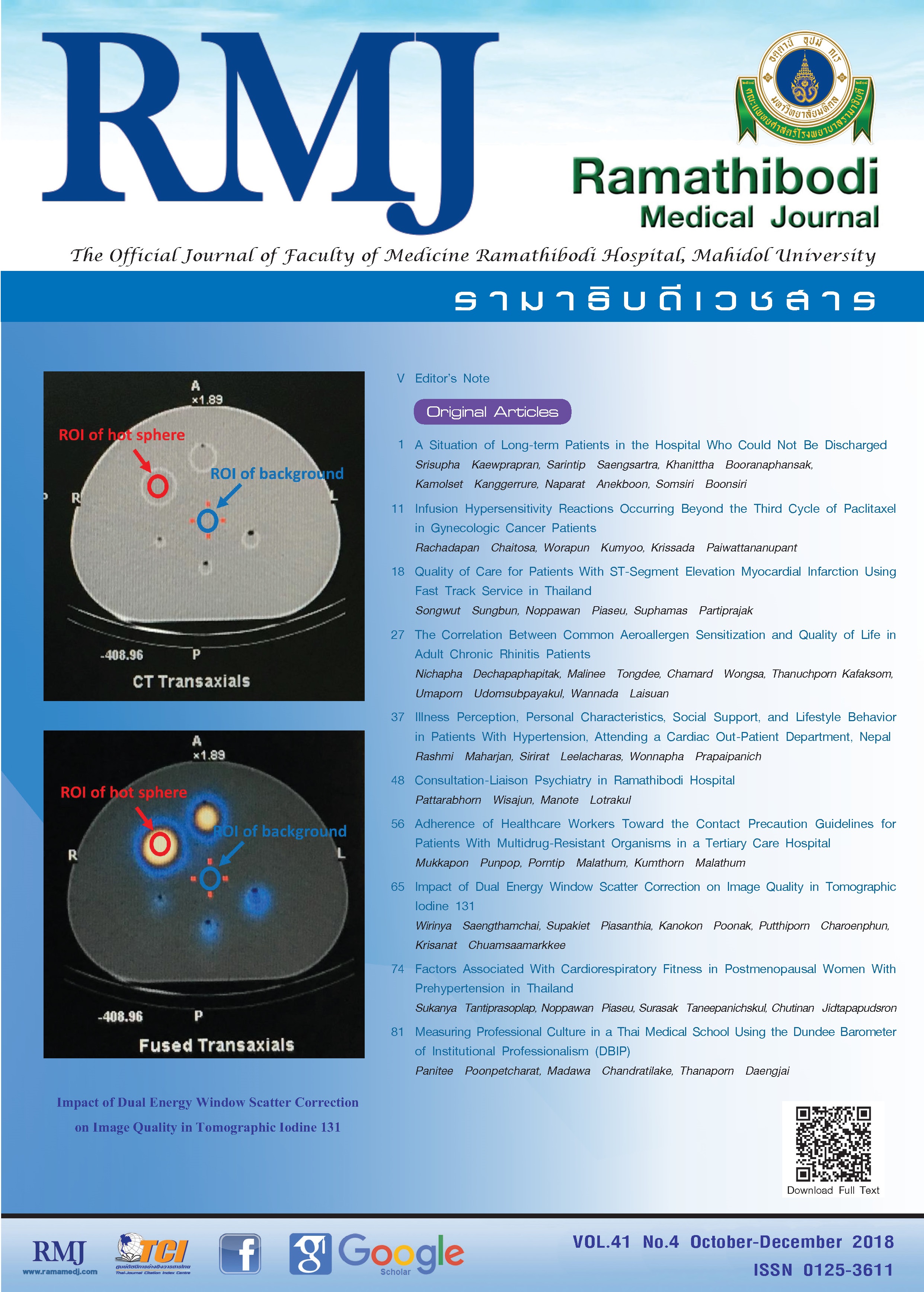Factors Associated With Cardiorespiratory Fitness in Postmenopausal Women With Prehypertension in Thailand
Main Article Content
Abstract
Background: Cardiorespiratory fitness (CRF) is one of the most important components of physical fitness. Low levels of CRF are associated with high mortality risk.
Objective: To investigate factors associated with CRF in postmenopausal women with prehypertension.
Methods: A descriptive design was used in this study. Through purposive sampling, 84 postmenopausal women with prehypertension were recruited from Ratchaburi province. The data were collected by using the structured questionnaire with face-to-face interview. All of the participants were measured for CRF (estimated maximal oxygen uptake [VO2max]). Data were analyzed using descriptive and inferential statistics.
Results: The results revealed that mean age of participants was 55.15 ± 7 years (range, 44 - 69 years). Most of them were married (69%), obtained primary education (76.2%), worked as farmer (76.2%), and none farmers (23.8%). Approximately half of them did not exercise (42.9%). CRF was associated with waist circumference
(rp = -0.637, P < 0.001), body mass index (rp = -0.562, P < 0.001), heart rate (rp = -0.581, P < 0.001), and occupation (rs = 0.396, P < 0.001).
Conclusions: Factors including waist circumference, body mass index, and heart rate were negatively associated with CRF in postmenopausal women with prehypertension. The results suggest approaches for healthcare providers to develop programs promoting cardiorespiratory fitness among postmenopausal women with prehypertension to enhance their health status and prevent hypertension and cardiovascular risk factors.
Article Details
References
2. Wang C-Y, Haskell WL, Farrell SW, LaMonte MJ, Blair SN, Curtin LR, et al. Cardiorespiratory fitness levels among US adults 20 - 49 years of age: findings from the 1999 - 2004 National Health and Nutrition Examination Survey. Am J Epidemiol. 2010;171(4):426-435.doi:10.1093/aje/kwp412.
3. Kaminsky, Leonard A. ACSM’s Health-Related Physical Fitness Assessment Manual. Baltimore, MD: Wolters Kluwer Health/Lippincott Williams & Wilkins; 2014.
4. Laaksonen DE, Lakka HM, Salonen JT, Niskanen LK, Rauramaa R, Lakka TA. Low levels of leisure-time physical activity and cardiorespiratory fitness predict development of the metabolic syndrome. Diabetes Care. 2002;25(9):1612-1618. doi:10.2337/diacare.25.9.1612.
5. Adams-Campbell LL, Dash C, Kim BH, Hicks J, Makambi K, Hagberg J. Cardiorespiratory fitness and metabolic syndrome in postmenopausal African-American women. Int J Sports Med. 2016;37(4):261-266. doi:10.1055/s-0035-1569284.
6. Jae SY, Kurl S, Franklin BA, Laukkanen JA. Changes in cardiorespiratory fitness predict incident hypertension: a population-based long-term study. Am J Hum Biol. 2017;29(3). doi:10.1002/ajhb.22932.
7. DeFina LF, Leonard D, Willis BL, et al. High cardiorespiratory fitness is associated with reduced risk of low bone density in postmenopausal women. J Womens Health (Larchmt). 2016;25(10):1073-1080. doi:10.1089/jwh.2014.5170.
8. Warburton DER, Nicol CW, Gatto SN, Bredin SSD. Cardiovascular disease and osteoporosis: Balancing risk management. Vasc Health Risk Manag. 2007;3(5):673-689.
9. Faul F, Erdfelder E, Lang AG, Buchner A. G*Power 3: a flexible statistical power analysis program for the social, behavioral, and biomedical sciences. Behav Res Methods. 2007;39(2):175-191. https://www.gpower.hhu.de/fileadmin/redaktion/Fakultaeten/Mathematisch-Naturwissenschaftliche_
Fakultaet/Psychologie/AAP/gpower/GPower3-BRM-Paper.pdf. Accessed May 1, 2015.
10. Burr JF, Bredin SS, Faktor MD, Warburton DE. The 6-minute walk test as a predictor of objectively measured aerobic fitness in healthy working-aged adults. Phys Sportsmed. 2011;39(2):133-139. doi:10.3810/psm.2011.05.1904.
11. Dagan SS, Segev S, Novikov I, Dankner R. Waist circumference vs body mass index in association with cardiorespiratory fitness in healthy men and women: a cross sectional analysis of 403 subjects. Nutr J. 2013;12:12. doi:10.1186/1475-2891-12-12.
12. Sawada SS, Lee IM, Naito H, et al. Cardiorespiratory fitness, body mass index, and cancer mortality: a cohort study of Japanese men. BMC Public Health. 2014;14:1012. doi:10.1186/1471-2458-14-1012.
13. Stathokostas L, Dogra S, Paterson DH. The independent roles of cardiorespiratory fitness and sedentary time on chronic conditions and body mass index in older adults. J Sports Med Phys Fitness. 2015;55(10):1200-1206.
14. Lavie CJ, Archer E, Jahangir E. Cardiovascular health and obesity in women: is cardiorespiratory fitness the answer? J Womens Health (Larchmt). 2016;25(7):657-658. doi:10.1089/jwh.2015.5696.
15. Liu J, Sui X, Lavie CJ, et al. Effects of cardiorespiratory fitness on blood pressure trajectory with aging in a cohort of healthy men. J Am Coll Cardiol. 2014;64(12):1245-1253. doi:10.1016/j.jacc.2014.06.1184.
16. Lu Z, Woo J, Kwok T. The effect of physical activity and cardiorespiratory fitness on all-cause mortality in Hong Kong Chinese older people. J Gerontol A Biol Sci Med Sci. 2018;73(8):1132-1137. doi:10.1093/gerona/glx180.
17. Garber CE, Blissmer B, Deschenes MR, et al. American College of Sports Medicine position stand. Quantity and quality of exercise for developing and maintaining cardiorespiratory, musculoskeletal, and neuromotor fitness in apparently healthy adults: guidance for prescribing exercise. Med Sci Sports Exerc. 2011;43(7):1334-1359. doi:10.1249/MSS.0b013e318213fefb.




